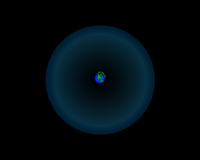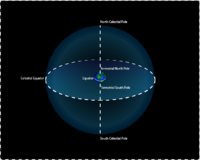Celestial sphere
(Create page) |
Revision as of 01:08, 12 August 2015
The celestial sphere is an imaginary sphere around the Earth in which the objects in the sky appear fixed to. If you look at the night sky, it does look somewhat like a bowl or half sphere over the ground. This appearance gave ancient astronomers the idea that a sphere surrounded the Earth and that the stars were fixed to this sphere, which then rotated around the Earth. The Sun, Moon, and planets were then thought to move against the celestial sphere around the Earth in their own orbits.
Now in modern times we know that there isn't a sphere around the Earth in which the stars are fixed. The stars are all at different distances from the Earth and the ones we can see with the unaided eye are all in our Galaxy and don't rotate around the Earth, but orbit the centre of our Galaxy. That being said it is often useful to think of the sky as a sphere around the Earth for the convenience of mapping and observing.
Parts of the Celestial Sphere
There are parts of the celestial sphere that are useful to know when talking about where things are in the night sky or defining the various coordinate systems used to locate objects in the sky.
Celestial Equator and Celestial Poles
If you project the Earth's equator onto the night sky you produce an imaginary line across the sky known as the celestial equator. This means that if you were standing on the Earth's equator looking due east, the celestial equator would start at the horizon, go straight up overhead and then down due west directly behind you. The height above the ground the celestial equator appears depends on how close you are (in latitude) to the Earth's equator.
If you project the Earth's geographic/terrestrial pole out onto the celestial sphere, you would then create the north and south celestial poles. Thus if you were to stand on one of the Earth's poles the and looked straight up you would be looking in the direction of one of the celestial poles (north if you were standing on the Earth's north pole, south if you were standing on the south pole). As with the celestial equator the height of the celestial pole depends on your latitude. In fact the height above the northern horizon of the north celestial pole is your latitude (change to the southern pole and horizon for south of the terrestrial equator).

